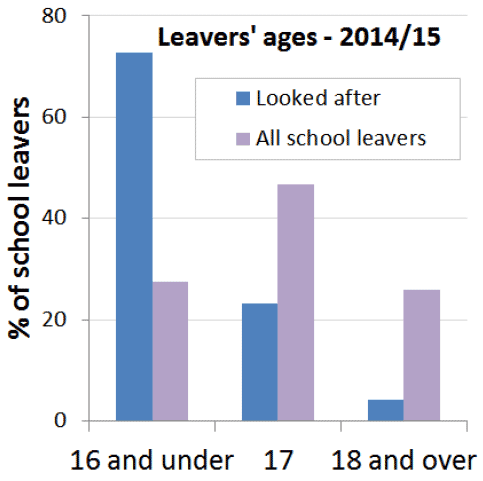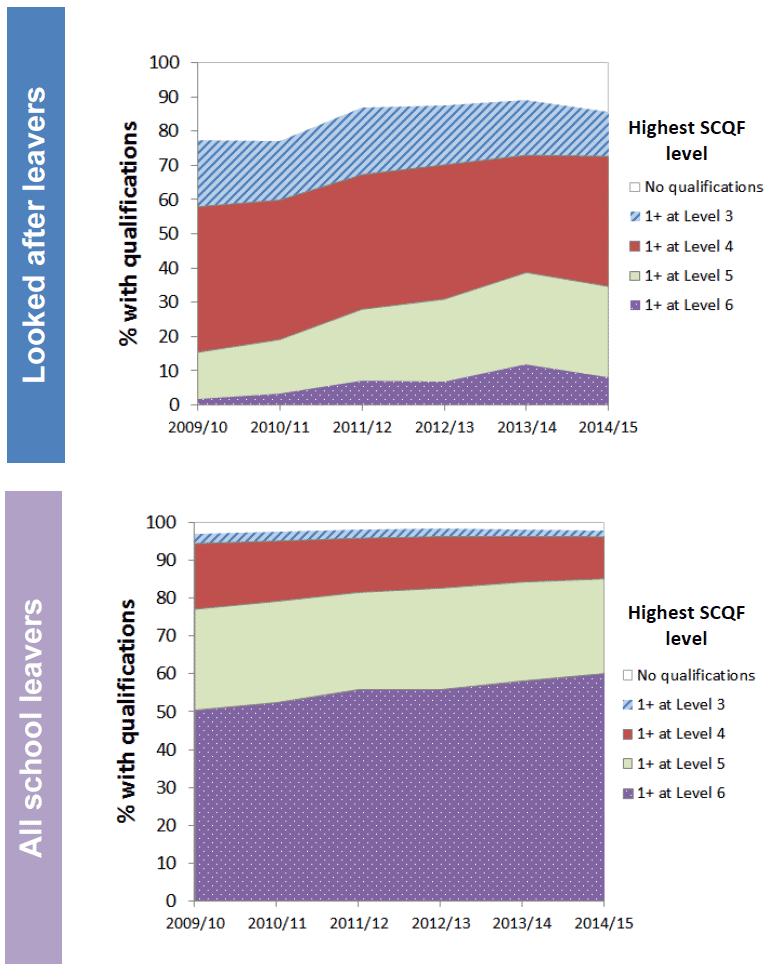Education outcomes for looked after children: 2014-2015
This publication links school and social work data to present information on the attainment, post-school destinations of looked after young people who leave school, and the school attendance and exclusion rates of all looked after children.
This document is part of a collection
Educational attainment

This section presents data on the educational attainment of the 427 young people who were looked after from 1 August 2014 to 31 July 2015 and who left school during 2014/15. All figures have been updated since previous publications following improvements in linking methodology and better coverage of Scottish Candidate Numbers, so should not be compared to previously published figures. All underlying data are available here: http://www.gov.scot/Topics/Statistics/Browse/Children/EducOutcomesLAC
Age of school leavers

Looked after children tend to have lower levels of educational attainment than non-looked after children. These differences are, in part, linked to the fact that looked after children tend to leave school at younger ages. In 2014/15 almost three quarters (73 per cent) of looked after school leavers were aged 16 and under ( i.e. they left school at the earliest point they could) compared to over one quarter (27 per cent) of school leavers more generally. The proportion of leavers who were aged 16 and under has improved since 2009/10, including among looked after leavers, but discrepancies between looked after leavers and other leavers remain consistent.
Highest level of qualification
Looked after children obtain lower qualification levels on average than all school leavers. In previous years, a system of Tariff Scores has been used to measure attainment. However, since 2013/14, leavers have been classified by identifying the highest Scottish Credit and Qualifications Framework ( SCQF) level at which they achieved one or more passes by the time they leave school. This includes SQA attainment at SCQF levels 3 to 7.
Standard Grades were no longer available in 2013/14 and Intermediate qualifications ceased to exist from August 2015. They have been replaced with the new National qualifications. The current leavers will have taken a range of qualifications, some may have taken the new National qualifications introduced in the 2013/14 academic year, but the majority will have taken the qualifications currently being phased out. Only 2013/14 S4 leavers and 2014/15 S4 and S5 leavers may have experienced Curriculum for Excellence throughout their school education, and this publication therefore does not measure the impact of the new system.
Illustration 3: Scottish Credit and Qualifications Framework ( SCQF) levels
| Level 3 | Access 3 National 3 Standard Grade (Foundation) |
|---|---|
| Level 4 | Intermediate 1 at A-C National 4 Standard Grade (General) |
| Level 5 | Intermediate 1 at A-C National 5 at A-C Standard Grade (Credit) |
| Level 6 | Higher at A-C |
| Level 7 | Advanced Higher at A-C |
Table 1.1: Percentage of all looked after school leavers by their highest level of attainment 2014/15
| Looked after leavers | All school leavers | |
|---|---|---|
| 1 or more qualification at SCQF level 3 or better | 86 | 98 |
| 1 or more qualification at SCQF level 4 or better | 73 | 96 |
| 1 or more qualification at SCQF level 5 or better | 35 | 85 |
| 1 or more qualification at SCQF level 6 or better | 8 | 60 |
| 1 or more qualification at SCQF level 7 | 1 | 19 |
| No qualifications at SCQF level 3 or better | 14 | 2 |
Older data available at http://www.gov.scot/Topics/Statistics/Browse/Children/EducOutcomesLAC
As can be seen in Table 1.1, while the level of qualifications of looked after school leavers shows the least difference to that of all school leavers at the lowest level of qualification (86 per cent of looked after school leavers have at least one SCQF level 3 qualification or better, compared to 98 per cent of all school leavers), the difference increases proportionally at higher levels.
Almost all school leavers (96 per cent) have at least one qualification at level 4 or better (see Illustration 3 for list of qualifications). This compares to almost three quarters (73 per cent) of looked after leavers with the same level of qualifications. At the higher levels of qualification, three in five of all leavers (60 per cent) have a at least one qualification at level 6 or better while fewer than one in ten looked after leavers (8 per cent) had qualifications at this level.
However, while looked after school leavers achieve less highly than school leavers more generally, educational attainment among looked after leavers has improved over the last five years, narrowing the gap. Chart 2 shows the highest level of qualification held by looked after leavers and all leavers over time (excluding level 7 for clarity, as numbers are very low among looked after leavers). The proportion of looked after leavers with no qualifications has fallen from 23 per cent in 2009/10 to 14 per cent in 2014/15. Over the same period the proportion of looked after leavers with one or more qualification at level 5 or better jumped from 15 per cent to 35 per cent.
Chart 2: Highest level of attainment of looked after leavers and all school leavers, 2009/10 to 2014/15

Highest level of qualification by type of accommodation
When a young person is looked after there are various types of residence in which they could be placed. Placements can be at home (where a child is subject to a Supervision Requirement and continues to live in their usual place of residence), foster care, a kinship care placement (where they are placed with friends or relatives) or a residential placement. Table 1.2 presents the attainment of looked after leavers with only one placement in 2014/15 by the type of that placement.
Table 1.2: Percentage reaching highest level of attainment of looked after school leavers with one placement for the year, by the accommodation type of that placement 2014/15 (1)
| 1 or more qualification at SCQF level 3 or better | 1 or more qualification at SCQF level 4 or better | 1 or more qualification at SCQF level 5 or better | |
|---|---|---|---|
| In the community | |||
| At home with parents | 63 | 36 | 6 |
| With friends/relatives | 86 | 81 | 41 |
| With foster carers provided by LA | * | 96 | 66 |
| With foster carers purchased by LA | * | 90 | 61 |
| In other community (2) | - | - | - |
| Residential accommodation | |||
| In local authority home | * | 64 | 15 |
| In voluntary home | * | 86 | * |
| In other residential (3) | * | 62 | * |
| All looked after | 86 | 75 | 40 |
(1) Cells containing * represent small numbers that have been suppressed to maintain confidentiality.
(2) Includes with prospective adopters.
(3) Includes in residential school, secure care accommodation or crisis care.
Educational attainment varies across the types of accommodation in which looked after children are placed. Overall, more than eight in ten looked after school leavers achieved at least one qualification at SCQF level 3 or better. Children in foster care provided and purchased by the LA perform well (66 and 61 per cent respectively achieving at level 5 or better). School leavers looked after at home had the lowest overall levels of attainment, with six per cent achieving at least one qualification at level 5 or better, compared to 40 per cent for looked after leavers as a whole. It is unclear whether the relative success of those in foster care is because these settings encourage better outcomes, or because the circumstances of the people placed within them are more positive - the reason is potentially a combination of these things.
Highest level of qualification by number of placements
Looked after school leavers who experience more placements in the year tend to have lower levels of qualifications. Table 1.3 shows that three quarters (75 per cent) of looked after leavers who had just one placement all year achieved one or more qualification at level 4 or better compared to more than six in ten (62 per cent) of looked after leavers who had 4 or more placements during the year.
This trend is more noticeable at higher levels of qualification. 40 per cent of leavers with one placement reached level 5 or better, whereas less than a quarter of those with more placements achieved so highly.
It should be noted that the numbers of young people with larger numbers of placements is small and care should be taken when interpreting these figures.
Table 1.3: Proportion of looked after school leavers achieving qualifications by number of looked after placements they had in 2014/15 (1)
| 1 or more qualification at SCQF level 3 or better | 1 or more qualification at SCQF level 4 or better | 1 or more qualification at SCQF level 5 or better | |
|---|---|---|---|
| 1 placement | 86 | 75 | 40 |
| 2 placements | 88 | 65 | 24 |
| 3 placements | 73 | 64 | * |
| 4 or more placements | * | 62 | 0 |
| All looked after | 86 | 73 | 35 |
(1) Cells containing * represent small numbers that have been suppressed to maintain confidentiality.
Cross- UK comparisons
The improvements seen in the proportion of looked after children in Scotland achieving qualifications since 2009/10 mirrors the general trend across the UK. Because of differences in the education systems between Scotland and the rest of the UK (and in the ages at which looked after children's qualifications are measured) it is not possible to directly compare qualification levels of looked after children. See background note 5.3 for further information.
Contact
There is a problem
Thanks for your feedback